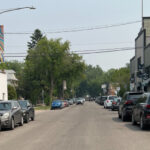When former Saskatchewan Marathon champion Brooke MacDonald moved to La Ronge in 2019, she thought her days of running at a high level were behind her. She didn’t know how she’d be able to log more than 100 kilometres a week in a northern community where there were no sidewalks and where wildlife and stray dogs were a constant concern.
Yet it didn’t take long for MacDonald to realize she could still train hard in La Ronge — it would just look different than training in the more urban centres of Saskatoon or Yorkton where she had lived before. This spring she completed a 3:02 marathon on a windy day as part of the virtual Saskatchewan Marathon and she’s gearing up to run the half at the GMS Queen City Marathon.
Today, she shares some advice with the Brainsport Times about how to train hard in rural Saskatchewan.
Listen to your body
Some small communities lack sidewalks and paved roads. That means you might need to get creative in where you run, including hitting up gravel roads, dirt trails or even packed skidoo trails in the winter. These surfaces are not as fast as asphalt — so don’t expect them to be. “If I’m running on an ice road, it’s not going to be fast,” MacDonald said. “I’ve just been learning to listen more to my body and know how I feel rather than looking at paces all the time on my watch.”
Get comfy with accessories
When MacDonald heads out the door for a run she carries her phone so she can call for help if she encounters trouble because she may not see another person along her route. Because there are no water fountains, she brings water on long runs. In the summer, she totes bear spray (though she hasn’t had to use it yet). In the winter, when many of her runs are done in the dark she runs with a headlamp because there is not much outdoor lighting MacDonald knows running with so much gear may affect her pace and so doesn’t worry too much about the numbers.

Lose the headphones
Running with headphones can always pose a risk, but this is particularly true for rural areas, where wildlife may be more abundant. “Wearing headphones is definitely not something we can do here as runners,” MacDonald says. Eschewing headphones has the added benefit of allowing her to take in the sounds associated with running alone in nature — sometimes all she can hear is the crunch of her footsteps, the puff of her breath and otters chomping away on walleye.
Learn to love the treadmill
Speedwork is part of every good marathon build and sometimes, particularly in winter, that can be hard to do safely in a rural area if there is limited snow clearing. One of MacDonald’s first purchases upon moving to La Ronge was a treadmill and she often does hard workouts on the machine if the weather is poor — or if there are particular concerns about wildlife near her home.
Stock up on shoes
Sadly Brainsport doesn’t have brick-and-mortar franchises in Saskatchewan’s rural communities, which means obtaining running gear, including running shoes, in rural areas can require some advance planning. MacDonald orders online or picks running items in bulk when she visits family in the city.
To learn more about MacDonald’s training, check her out on Instagram @NorthernSkRunner and read her interview in the Saskatoon StarPhoenix from earlier this year.









